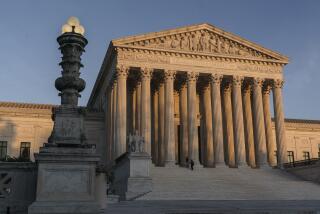4,000 Cases, but We See Only One : William Brennan: It’s a pity that the debate on his successor will focus on abortion, since the court’s concern is the whole sweep of the Constitution.
- Share via
When William J. Brennan was nominated to the U.S. Supreme Court in 1956, the hottest issues before the court were the prosecution of communists under the Smith Act, the power of Congressional committees to investigate individuals, and the implementation of school desegregation orders. Through the 34 terms during which he sat, the parade of issues sweeping past the court touched every aspect of American life. He participated in more than 4,000 decisions, each eagerly awaited in order to settle a fiercely contested legal question. Many of the cases on the court’s 1990 docket presented questions that couldn’t even have been imagined in 1956.
Unfortunately, the debate over Brennan’s successor is likely to focus on only one of those 4,000 decisions. Brennan was one of four justices still on the court who are committed to Roe vs. Wade, the 1973 decision that gave constitutional recognition to a woman’s right to choose abortion. The fate of the decision hangs in the balance, with Justice Anthony Kennedy, the court’s most recent appointee, joining three others apparently ready to overrule Roe in the 1989 decision, Webster vs. Reproductive Health Services. Justice Sandra Day O’Connor has been the so-called swing vote.
The bruising contest over the nomination of Robert Bork was largely engendered by his clearly articulated rejection of the legitimacy of the constitutional right to privacy, the premise of Roe. That was a mistake that won’t be repeated. Kennedy sailed through confirmation largely because his position on the abortion issue was a mystery, although his Roman Catholic religion gave anti-abortion forces some basis for optimism.
Any judge who has already staked out a position on abortion can abandon hope of nomination. Thus, the “litmus test” will not be a position on abortion, but the lack of a public position. Such a nominee can take refuge in the traditional refusal to comment on issues likely to come before the court.
The lack of an articulated position for or against the right to abortion, and the refusal to take a position, will hardly remove the issue from the confirmation process. It will simply shift the debate to a process of inference. Both sides will strive to find some thread in a decision or personal predilection of the nominee on which they can hang a label.
But this predictable exercise brushes aside the 3,999 or so other cases in which Brennan helped shape our law. Many of them are now accepted and familiar principles, making the controversy that greeted them startling to a modern observer. Baker vs. Carr established the principle of “one person, one vote”; New York Times vs. Sullivan gave the press protection against libel actions by public officials; Moore vs. East Cleveland protected the right of extended families to live together; and Katzenbach vs. Morgan struck down literacy tests that had disfranchised thousands of voters of Puerto Rican background. All of these were close decisions in which Brennan led the majority.
More recently, Brennan has issued pungent dissents to a shifting court’s erosion of First and Fourth Amendment rights, access to the courts and civil rights laws.
Single-issue politics makes no more sense in the selection of Supreme Court justices than it does in the selection of Presidents and legislators. The person nominated to fill Brennan’s seat should be closely scrutinized. But the scrutiny should be as broad as the sweep of our Constitution. And the focus should be on the nominee’s commitment to the basic values that the Constitution protects. Labels such as “liberal,” “conservative,” “pro-life” or “pro-choice” will not enlighten that process.
Brennan endured lots of labels. I vividly recall his commencement address at Loyola Law School in Los Angeles five years ago, when he spoke with great dignity as an airplane circled above, pulling a banner that read, “Baby Killer Brennan.” Such labels will soon be forgotten. The 4,000 decisions will live on in our law.
More to Read
Get the L.A. Times Politics newsletter
Deeply reported insights into legislation, politics and policy from Sacramento, Washington and beyond. In your inbox twice per week.
You may occasionally receive promotional content from the Los Angeles Times.










